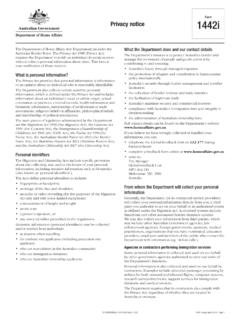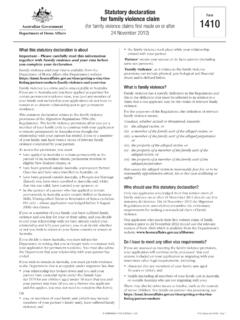Transcription of Oil and gas taxation in Norway - Deloitte US
1 oil and gas taxation in Norway Contents Summary 1 Indirect taxes 7. Corporate income tax 1 Value added tax, goods and 7. services tax, and sales and use tax Rates 2. Area fee 7. Taxable income 2. Customs duties 8. Revenue 2. Environment taxes 8. Deductions and allowances 2. Stamp tax 8. Losses 4. Other 8. Foreign entity taxation 5. Choice of business entity 8. Tax incentives 5. Foreign currency 8. Payments to related parties 5. Oil and gas contact information 9. Transfer pricing 5. Thin capitalization 6. Interest deductibility 6. Transactions 6. Withholding taxes 7. Dividends 7. Interest 7. Other 7. Tax treaties 7. Deloitte taxation and Investment Guides Oil and Gas Tax Guide Tax professionals of the member firms of Deloitte Touche Tohmatsu Limited have created the Deloitte International Oil and Gas Tax Guides, an online series that provides information on tax regimes specific to the oil and gas industry.
2 The Guides are intended to be a supplement to the Deloitte taxation and Investment Guides, which can be found at For additional information regarding global oil and gas resources, please visit our website: Summary The Norwegian Oil and Gas taxation Code includes direct and indirect taxation . Direct taxation plays the most important role for companies investing in upstream activities on the Norwegian continental shelf. This summary on Norway relates to exploration and production activities on the Norwegian Continental Shelf ( NCS ), as there are no onshore activities in Norway . In order to explore and produce petroleum resources on the NCS, a licence is needed from the Ministry of Petroleum and Energy ( MPE ). The petroleum activities on the NCS are governed by The Law on Petroleum Activities dated 29 November 1996, which provides extensive rules in respect of rights and obligations for licensees.
3 The Norwegian petroleum tax system is based on the taxation of the entity rather than taxation of specific petroleum assets. Direct taxes consist of: ordinary petroleum tax 27%. special tax 51%. Losses, as a rule, may be carried forward indefinitely. The tax value of exploration costs (78%) may be refunded from the Norwegian state annually. Moreover, the tax value of unused losses when finally ceasing exploration/production activities on the NCS will be refunded by the Norwegian state. Indirect taxes include carbon dioxide taxes and nitrogen oxide tax. VAT, which generally is the main indirect tax in Norway , plays a limited role for companies engaged in exploration/production on the NCS as supplies to be used in upstream activities are zero rated. Corporate income tax The taxation of upstream activities on the NCS is regulated by the Petroleum Tax Act ( PTA ) dated 13 June 1975 and annual decisions made by the Norwegian parliament (regarding tax rates).
4 The PTA sets out the specific rules for the taxation of upstream petroleum activities. If there are no specific rules covering the particular situation in the PTA, the rules contained in the General Tax Act ( GTA ) will apply. There are, however, important differences between the rules stated in the PTA and the GTA. In this guide we have highlighted the rules stated in the PTA only, unless there are any relevant areas specified elsewhere. We have not commented on tax issues which are relevant for other activities such as oil service activities on the NCS (such activities are essentially only regulated by the rules in the GTA). It should be noted that costs may be deductible against income taxable under the PTA even if the costs are actually incurred onshore Norway or elsewhere, provided that the costs relate to taxable activities in accordance with the PTA.
5 This will typically be relevant with respect to administrative costs, but may also for instance apply to tax depreciation of assets located onshore. Where a company also performs activities that are taxable in accordance with the GTA (where the tax rate is 27%), any costs incurred should be allocated between the different taxable activities according to the GTA and the PTA as if the upstream activities were conducted by a separate and independent legal entity ( based on the arm's length principle). Upstream petroleum companies in Norway are subject to both ordinary petroleum tax at the rate of 27% and an additional special tax of 51%. It should be noted that these taxes are calculated independently of each other. A deduction for the special tax paid is not allowed against the taxable income for ordinary petroleum tax and vice versa.
6 oil and gas taxation in India Deloitte taxation and investment guides 1. As a starting point, the basis for these taxes is similar. There are however two differences. These relate to: interest costs and other financial items; and additional depreciation (uplift) allowance when calculating the taxable income for special tax purposes. Norway does not operate a ring fencing system between different licences and fields on the NCS. However, for companies engaged in business activities other than upstream activities on the NCS, there are limitations as to what extent losses from onshore activities may be off-set against profits taxable according to the GTA (often referred to as onshore profits below). Moreover, the ordinary tax consolidation system in Norway between Norwegian group companies/branches of companies located in the EEA by way of group contributions, does not apply to upstream activities on the Norwegian continental shelf.
7 Rates The rate of ordinary petroleum tax is 27% for profits taxable according to the PTA. The special tax is charged at 51% as an additional tax on these same profits. The rate of ordinary corporation tax is 27%, for profits taxable according to the GTA. Taxable income Taxable income is gross income minus deductions. For the purpose of calculating ordinary petroleum tax and special tax, gross income includes revenues from production on the NCS as well as substitutes for such revenues, but not financial income such as interest receivable or gains on derivative agreements, even if such income is clearly linked to the production activities. Financial income is taxable according to the GTA only (as onshore income ). Costs incurred in order to obtain income of a taxable nature are deductible (limitations apply, for example with respect to entertainment expenses).
8 Costs are generally deductible when the tax payer has an unconditional obligation to pay these costs to another party. Revenue The PTA requires that when calculating taxable income, all petroleum transactions are recorded using a norm price . This norm price is applied regardless of whether the transactions are between related or unrelated parties. Consequently, a company will have different revenue figures for tax and accounting purposes. This difference is treated as a permanent difference. The petroleum price board fixes norm prices in arrears, normally each quarter. In recent years, with frequent oil price changes, the board has fixed monthly norm prices for crude oil. Contractual prices provide the basis for calculating the tax for dry gas. So far norm prices have only been set for propane. The norm price must correspond to the price at which petroleum could have been traded between independent parties in a free market.
9 The norm price is fixed on a discretionary basis after an overall evaluation of market conditions, taking several types of transactions, reference markets and methods of evaluation into account. Deductions and allowances Costs incurred in order to obtain income of a taxable nature (revenue from the sale of oil and gas) are deductible (limitations apply for example with respect to entertainment expenses). It should be noted that costs may be deductible against income taxable according to the PTA even if the costs are actually incurred onshore in Norway or elsewhere as long as the costs relate to taxable activities in accordance with the PTA. This will typically be relevant with respect to administrative costs, but may also for instance apply for tax depreciation of assets located onshore. Exploration costs All exploration costs are, as a starting point, deductible and may be off-set against profits from production.
10 oil and gas taxation in Norway 2. Moreover, companies may claim an annual cash refund of the tax value of direct and indirect exploration costs under ordinary petroleum tax and special tax (this amounts to 78% of such costs), with the exception of finance costs, with the amount of the refund limited to the tax value of the net tax losses. This is an alternative to carrying the losses forward. Abandonment costs Abandonment costs are deductible when the costs are actually incurred. Accounting provisions made in order to meet future abandonment costs are not deductible. Capital allowances (depreciations). When calculating the taxable income both for ordinary petroleum and special tax purposes, capital allowances are available. Capital allowances for investments made in productions facilities and pipelines and installations which are part of such production facilities and pipelines are calculated on a straight line basis over six years at a rate of per year from the date the capital expenditure was incurred.


















